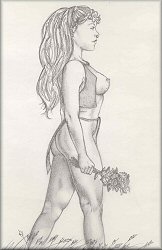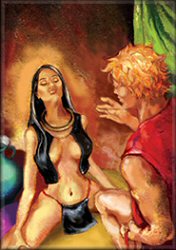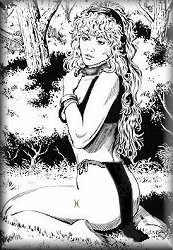Slave Livery
Slaves of MTC will dress in traditional Tuchuk attire. This consists of four (4) articles of clothing for female slaves and one (1) for male slaves. Slaves are generally kept barefoot.
For female slaves:
•Curla: A red cord tied about the waist.
•Chatka: A long, narrow (about 6" wide) strip of black leather that passes between the girl's legs and is held in place in front and back by the curla. It is slipped between the flesh and the cord and drawn up tightly, leaving the ends of the leather strip hanging in front and behind like a breechclout.
•Kalmak: A short, open, sleeveless vest of black leather.
•Koora: A strip of red cloth matching the curla which is wound around the head to secure the slave's hair. In the books, Tuchuk slaves are not permitted to braid their hair or bind it in any other fashion.
 ... ... ... ...
Silks will be worn on the occasions of dancing and special events. They are also permitted on weekends, provided each slave's Master/Mistress allows.
For male slaves:
•Kes: a short sleeveless tunic of black leather.
“Among the Wagon Peoples, to be Clad Kajir means, for a girl, to wear four articles, two red, two black; a red cord, the Curla, is tied about the waist; the Chatka, or long, narrow strip of black leather, fits over this cord in front, passes under, and then again, from the inside, passes over the cord in the back; the Chatka is drawn tight; the Kalmak is then donned; it is a short, open, sleeveless vest of black leather; lastly the Koora, a strip of red cloth, matching the Curla, is wound about the head, the hold the hair back, for slave women, among the Wagon Peoples, are not permitted to braid, or otherwise dress their hair; it must be, save for the Koora, worn loose. For a male slave, or Kajirus, of the Wagon Peoples, and there are few, save for the work chains, to be Clad Kajir means to wear the Kes, a short, sleeveless work tunic of black leather.”—Nomads, 30
“Gracefully, insolently, the silken yellow sheet moved about and across her body and fell from her. She stood facing me, in pretended anger, graceful and beautiful. She wore the Sirik and was, of course, clad Kajir, clad in the Curla and Chatka, the red cord and the narrow strip of black leather; in the Kalmak, the brief vest, open and sleeveless, of black leather; and in the Koora, the strip of red cloth that bound back her brown hair. About her throat was the Turian collar with its chain, attached to slave bracelets and ankle rings, one of the latter attached to the chain running to the slave ring. I saw that her left thigh, small and deep, bore the brand of the four bosk horns.”—Nomads, 282
Other Types of Slave Livery
Slave silks: Sheer diaphanous, sensual, soft, alluring, they leave little of the slave's form to the imagination. Usually opaque silks are worn for day wear, the sheerer variety for evening wear when serving or dancing.
“I hurried back, elatedly, through the beaded curtain, fleeing, laughing, from the dancing floor. I had scrambled on my knees for the coins flung to the floor, seizing them, thrusting them hastily, so many of them, with one hand, into the lifted, bunched portion, held by my other hand, of the dancing skirt, a lovely, swirling skirt, scarlet, open on the right, of diaphanous dancing silk. I had been permitted a scarlet halter of the same material. My midriff, like my right thigh, was bared. The skirt was low on my hips. I wore a double belt of threaded, jangling coins, one strand high, one low, as with the corded belt of metal pieces I had worn in my virgin dance, weeks ago. I also wore a triple necklace of coins, together with necklaces of slave beads, of both glass and wood. These coins, all of them, would be counted by Mirus when I disrobed. On my left ankle were bound slave bells. My right ankle wore several anklets. I was barefoot. On my wrists were bracelets. On my upper left arm was a coiled armlet. A ruby, held by a chain, was at my forehead. Wound in and about my hair were strands of pearls.”-Dancer of Gor, 223-224
“There are a large number of ways in which slave silk is worn. It can be worn, for example, on the shoulder or off the shoulder, with high necklines or plunging necklines, in open or closed garments, tightly or flowingly, and in various lengths. Sometimes it is put on the girl only in halters and G-strings, or mere G-strings. Sometimes it is done, too, in strips wound about her body. The tying of slave girdles, with such silk, and otherwise, to emphasize the girl’s figure and make clear her bondage, is an art in itself. Often, too, and as usually in paga taverns, it is worn in brief tunics. Most of these are partable or wraparound tunics. Such may be removed gracefully. Some tunics, however, like some regular slave tunics, have a disrobing loop, usually at the left shoulder, where it may easily be reached by both a right-handed master and a right-handed slave. A tug on the disrobing loop drops the tunic to the girl’s ankles, also gracefully.”-Dancer of Gor, 225
Camisk: Worn much like a poncho, this is a rectangle of cloth with a hole cut for the head.
Ta-teera: The literal translation is "slave rag". They are usually scant and made of rep-cloth.
Tunics: State slaves and government slaves wear tunics of gray, sleeveless and slashed to the waist. They wear matching gray collars as well. House slaves may wear similar tunics of various colors, prints, materials, and designs, but all are slave-short.
Hunter's catch: A garment made with netting, usually worn when entertaining important guests.
Red silk: This term signifies ONLY that the slave has been opened to the use of men and is, in other words, a non-virgin. Any slave may wear silks of red.
White silk: This term signifies ONLY that the wearer is a virgin. A white silk slave may have her collar wrapped with a bit of white silk to warn Masters that she is not for sexual use.
“…She took a white, silk ribbon and wrapped it five times about the collar, not tying it.
“I had been marked white silk.
“Inge and Rena laughed. ‘Do not laugh,’ smiled Ute, ‘for you, too, will be so marked, lest Raf and Pron, huntsmen of Treve, in a careless moment, devour my two other white-silk pretties.’”—323
Slave Types
The following descriptions detail the sorts of slaves that are to be found on Gor. Most of these slaves exist in cultures other than that of the Wagon Peoples.
•Bath girl: A slave who is trained to work in the bath houses of major cities.
•Below-deck slave: One of any number of slaves who are kept naked, head shaved, in small cages below the decks of sailing vessels.
•Bond girl: A slave used by the peasants. This entails a hard, laborious slavery involving field work.
•Bond-maid: The term for a slave girl of Torvaldsland. She is also referred to as "a girl whose belly lies beneath the sword," because the girl sleeps at the foot of her Master, literally lying under His sword. When claiming a slave, Jarls of Torvaldsland draw a circle in the ground, called a "bonds-maid circle." A woman may enter of her own free will, though this is not necessarily the case, and is then bound by custom, thus becoming a bond-maid or slave. Also, these slaves do not wear the typical locked Gorean collar. Instead, they wear the Torvald collar, a simple black band that is hammered into a half circle. The girl lays her neck into the metal band, which is then formed the rest of the way, being hammered and bolted shut.
•Cage girl: One of a number of slaves who resides in the cages above the decks of ships and exists to serve the pleasures of the sailors.
•Coin girl: This is a slave girl who, with a coin box and a triangular flat bell chained around her neck, is sent out in the streets to earn money for her Master - usually paga tavern owners - in return for her sexual use. These girls are very aggressive, knowing that if they do not bring home ample coin, they will be beaten severely.
•Display slave: This is a slave girl whose primary purpose is for the display of her beauty to reflect the affluence of her Master. She is often chained in a coffle with other display slaves behind the palanquin or other transport of her Master.
•Exotic slave: A male or female slave who was bred for a particular trait that is appealing or unusual, such as full lips, beautiful eyes, or large ears.
•Fetch-and-Carry girl: A slave selected to bring food and water to laboring slaves.
•Field slave: A slave who works the farms outside the walls of a city.
•Flute girl: A slave who plays the flute for various reasons and occasions--usually when someone is being driven from a city.
•Galley slave: A male captive made to work a ship's oars.
•Kajirus: A male slave. In the traditional sense, per the writings of John Norman, male slaves are generally not sexual pets for Free Women, but are often assigned heavy laborious tasks. Most male slaves are captives of war or criminals, and they are seen as simply animals of the lowest sense. There are instances in which a Free Woman has kept a male slave or two for sexual use; however, because the Free Woman fears her own slavery, she is rarely satisfied with their use. Yielding to the male slave could put her in great risk that the slave would turn the tables upon her, claiming her as his slave. The best male silk slave is a man of Earth, for the Gorean male is dangerous and understands his place in nature.
•Kettle: A slave who works in kitchens, both public and private.
•Kettle-and-mat girl (also called pot and mat): A slave who works in kitchens and also serves the sexual pleasures of men.
•Lure girl: A slave used to lure and distract a male so that he might be robbed or captured and sold as a labor slave.
•Mill girls A slave who works the cloth mills.
•Paga slave: A female slave who serves in taverns, her use complimentary with the price of a cup of paga.
•Passion slave: This is a slave girl who has been bred, not captured. Such breeding is for a particular trait, such as exquisite beauty or the shape of her lips. Not to be confused with a pleasure slave.
•Peasant slave: A slave who is owned by peasants and whose life is full of hard work.
•Pierced-ear slave: This is a slave girl whose ears have been pierced, considered the ultimate degradation to a woman. Because the piercing of the ear is noticeable to the naked eye, it guarantees that the girl will never be freed. Interestingly enough, women of the Wagon Peoples, whether Free or slave, openly accept nose piercing. Such women proudly wear the golden ring of their People in their septums. It is thought that perhaps with the nose ring removed, the hole is not as noticeable.
•Pleasure slave: This is a slave who has been specifically trained in the complete arts of pleasure. A true pleasure slave knows how to carry herself with sexual allure, instinctively kneels in the position of a pleasure slave, and knows all other positions a Master may desire her to attain, as well as the 12 kisses of pleasure, the caresses, and the massages. She also knows many dances and how to cook, serve, and bathe. She knows well all the skills necessary to perform exquisitely for her Master.
•Public slave or state slave: A slave who works in the central kitchens in cities, who cleans and does laundry, and who cares for children (without instructing them) for a nominal fee paid to the city.
•Rent slaves: Slaves who are rented out from their Masters for any purpose short of injury, mutilation, or death
•Slavery of the she-quadruped: A disciplinary form of slavery in which the slave is kept on all fours and not allowed to speak or behave in any way other than that of an animal. It is used a great deal on captive Ubaras.
•Tower slave: Her duties are primarily those of a maid or domestic help, though she can be used any way her Master sees fit.
•Whip slave: A slave who holds whip rights over other slaves. In MTC, this right is held only by ~prism~{RgR*1*) Ubar’s pagar and the slaves of the training team.
General Info
. .
Men. .
Men. .
Women
. .
Women
. .
Slaves. .
Slaves. .
Visitors .
Visitors
|
|
|
|